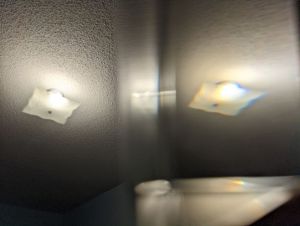14 Lab 4: Refraction of Light
liyuchon
Acknowledgment
This project is made possible with funding by the Government of Ontario and through eCampusOntario’s support of the Virtual Learning Strategy. To learn more about the Virtual Learning Strategy visit: https://vls.ecampusontario.ca.
PHY100 Stay-At-home Experiment 4
Refraction of Light
What you will do
Observe the refraction of light through a prism
What you will need
- A prism
- A flashlight (such as one from the back of a cell phone)
- A cardboard paper box
- A knife
- Some tape or glue
- A piece of blank, white paper
Procedures
- Precaution: Try to hold the prism only by its top and bottom surfaces. Holding it by the sides will leave fingerprints on the sides.
- Put a small object directly behind the prism, rotate the prism to various angles, and see if you can see the object through the prism.
- Put the small object at various locations. Familiarize yourself with how the prism lets you see the object from various directions. Note that in addition to refractions, it is also very likely to see reflections in the prism.
- Take a cardboard box. Cut a slit (less than 5mm wide) on one side of a cardboard box, and a small window (about 3cm by 3cm) on the opposite side of the cardboard box. Now you can shine a flashlight at the window to create a narrow light ray through the slit.
- Close the curtains or turn off the lights. Send the light ray through the prism, and observe how light travels through the prism.
Reporting and discussions
- (1/5 point) Hold the prism close to (but not immediately next to) the camera of your phone. Point your camera to an object a few meters away. Adjust the position and the orientation of the prism so that in the same photo, you can see the same object twice: once directly by the camera, another one indirectly through the refractions of the prism. Attach the photo to your report. (An example is shown below.)

- (1/5 point) In your photo above, light from the object took two paths to reach your camera. Do you think the light spends the same amount of time on each path? Why or why not?
- (2/5 points) If you look at any object through the refraction of the prism, the object should have one edge colored blue, and the opposite edge colored red. But if you look at the same object through the reflection of the prism, the edges of the object are not colored. Briefly explain why. (You can search online for the principles of reflection and refraction.)
- (1/5 point) Shine a narrow light ray through the prism, turn the prism so that you see the transmitted light ray spreading into rainbow colors. Sketch all the rays (either on paper or digitally), and indicate which side of the transmitted ray is red and which side is blue.
NOTE: the word limit for all questions is 100.

